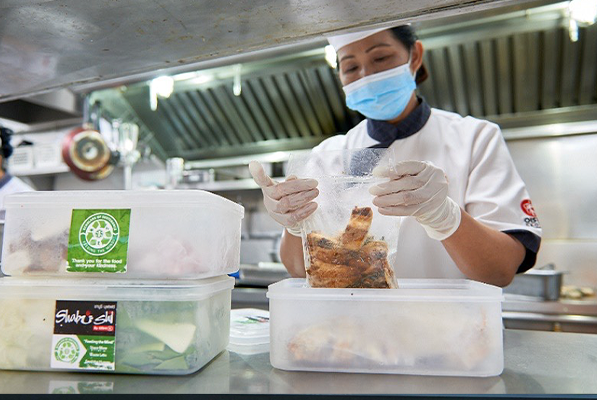Food Loss and Food Waste are both waste from ThaiBev’s food products, which can be differentiated from where they were created as follows:
 Waste from food products in:
Waste from food products in: harvesting, transportation, and production levels
Related ThaiBev’s operations: OISHI Food Service Co.,Ltd’s production operations at Ban Bueng Factory
 Waste from food products in:
Waste from food products in: retail level
Related ThaiBev’s operations: ThaiBev’s restaurant chains and food stores under OISHI, QSA, and FOA
At the production site, food loss occurred in production processes will be captured, collected, directly weighed, and then stored together to be sold to different partners depending on the type of waste, while parts that are unable to be sold or utilized will then be collected and properly stored for further disposal. Furthermore, weight difference calculation between full truck load and empty truck load is implemented at the production site to record the weight of waste (food loss) if necessary.
At the retail/restaurants level, food waste is collected and manually weighed in the back of each restaurant to calculate the amount of food waste created on a daily basis; along with the usage of the restaurant’s inventory systems as a proxy data to estimate any remaining data that are not manually weighed. Food waste that are suitable to be utilized for further purposes will be separated from other food waste, with the remaining waste being sent for disposal as the end of each day.
The most important thing in food loss and waste management is to find possibilities of using food loss and waste for various purposes, which also guarantees that those food loss and waste will not end up in a landfill. ThaiBev has many programs to utilize food loss and waste for various benefits.
In 2023, the amount of food loss and waste used for alternative purposes is 1,565.44 metric tonnes. Its destinations can be broken down as follows:
- Food loss and waste used for animal feed – 229.04 metric tonnes
Food waste created during the food preparation and manufacturing process within the Company’s factories were donated to the community for use as animal feeds. These waste ranges from flour, bread, vegetable, and food scraps – to other unqualified or expired ingredients that were deemed unusable.
- Food loss and waste used as fertilizer – 0.29 metric tonnes
Vegetable scraps were transformed and sent to the community to utilize as fertilizers.
- Food loss and waste used for biofuel – 1,316.36 metric tonnes
Used vegetable oil were sold to suppliers in order to subsequently recycled into biofuel / biodiesel.
- Food loss and waste sold as by products – 3.40 metric tonnes
Bread crumbs and salmon waste were repurposed into new food products, such as salmon skin snack.
- Food loss and waste donated – 16.35 metric tonnes
Leftover food that still maintained a degree of nutritional value and were still edible have been donated to various charitable foundations and programs to provide food to the less fortunate.

Shabushi (Shabu buffet restaurant chain) created the “Kin Mod Kliang” challenge for its customers. “Kin Mod Kliang” means “Eat it all so there’s no food waste.” The slogan reminds people to be considerate and reduce their food waste. Since Shabushi is a buffet-style restaurant, the consumers are at liberties to take as much food as they wish – sometimes an exceedingly large amount that they are unable to finish. This campaign raises consumers’ awareness not to take too much food at a time. The challenge operated in 200 branches across the country (175 branches of Shabushi, 7 branches of Oishi Buffet, 13 branches of Oishi Eaterium, and 5 branches of Nikuya), with a total of 250,819 customers participating; and raising their awareness of the issue of food waste.
There are standards in place to ensure proper management on raw materials and food ingredients. For example, on raw material receiving from suppliers, the quality of raw material will be carefully checked before getting handed over to ThaiBev. Raw materials and food ingredients which do not pass the standard will not be accepted to reduce the chance to waste the materials without them being used. Accepted items will then be properly stored depending on the need of each item to ensure that they will not go to waste.






